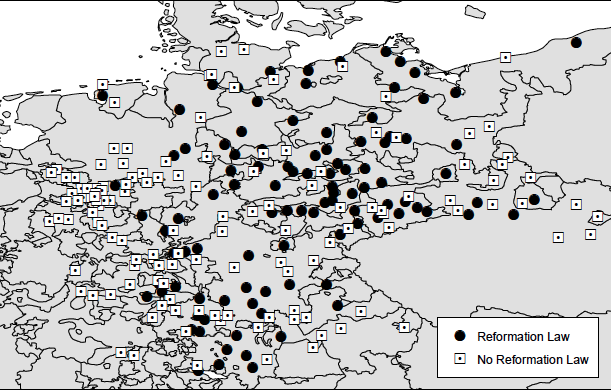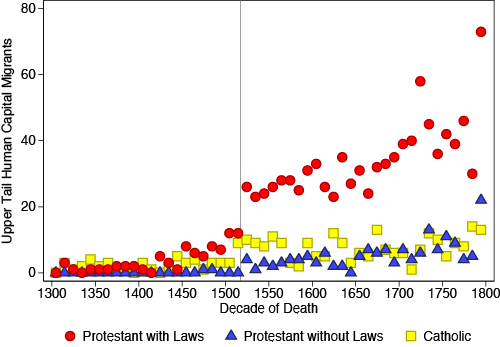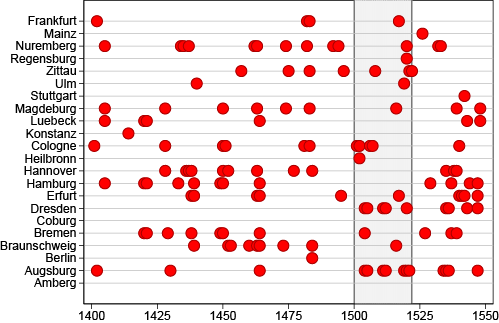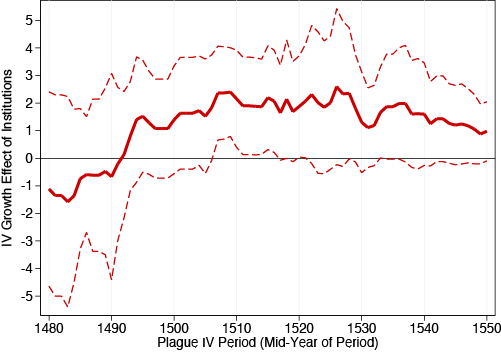The state can be a rent-extracting institution or a provider of public goods. What happens when the state becomes the provider of public goods?
Recent research suggests that where states have greater capacity to provide public goods, economic outcomes may be superior (Besley and Persson 2009, 2010, Acemoglu et al. 2015). The economics literature has emphasised expansions of state capacity that emerged for geostrategic and military reasons in European history ‘from above’.
In a recent paper (Dittmar and Meisenzahl 2016), we study a unique experiment that shifted legal institutions at the local level – the institutional public goods programme of the Protestant Reformation in Germany.
The institutions that we study were city-level laws that established Europe's first large-scale experiments with mass public education and significantly expanded the social welfare bureaucracies and state capacities of cities. These legal institutions established a fundamental innovation in funding and oversight for municipal activities – the ‘common chest’, a literal box of funds used to support public services. Significantly, the adoption of these institutions reflected popular political mobilisation.
In our research, we study the local variation in institutions and answer three interrelated questions:
- How did these innovations shape development?
- Why did some but not all cities adopt these institutions?
- What was the political process driving these transformations in German society?
Mapping an institutional upheaval
The local adoption of these new legal institutions was highly variable. In fact, fewer than 55% of cities that adopted Protestantism established legal institutions to support the provision of public goods. We observe variation across neighbouring cities in the same territory, subject to the same territorial lord.
Figure 1. The institutional geography that emerged across German cities by the late 1500s
The impact of institutions on long-run development
We test the hypothesis that cities with city-level Reformation laws by 1600 subsequently grew relatively quickly. Our first finding is that cities that adopted the Reformation institutions grew to be at least 25% larger in 1800 than observably similar cities. In contrast, we find no variation in growth associated with Protestant religion conditional on public goods institutions.
Historical evidence suggests that migration drove city growth in pre-industrial Europe (de Vries 1986, Bairoch 1991, Reith 2008). Existing quantitative evidence on migration is limited. We collect novel microdata on the migration and local formation upper tail human capital (Mokyr 1999, Squicciarini and Voigtlander 2015). Our data, drawn from the Deutsche Biographie, comprise thousands of the most important cultural and economic figures in German history between 1300 and 1800 – jurists, merchants, writers, artists, composers, and educators. We use the data to document the human capital response to institutional change.
Figure 2 shows how migration responded to institutional change by plotting the number of upper tail human capital migrants observed in cities that adopted public goods laws, cities that became Protestant but did not formalise public goods provision, and Catholic cities. These cities were attracting similarly small numbers of migrants before the Reformation, which is marked by the vertical line at 1518. A large shift in migration towards cities with public goods institutions appears in the 1520s, as legal reforms were passed. This gap persisted over the next 200 years and notably was driven by differences in migration from small towns to cities, not by a ‘brain drain’ from less to more desirable cities.
Figure 2. Response of migration to institutional change
We similarly find that cities with public goods institutions began producing more upper tail human capital starting after 1520. We find no differences in the local formation of upper tail human capital before the Reformation and 50-200% higher formation of upper tail human capital after the Reformation when we compare cities with laws supporting public goods provision to cities without these institutions.
Why not all cities adopted public goods institutions
The Protestant Reformation was both a religious revival movement and an anti-corruption movement with an institutional agenda. The institutional agenda was designed to expand the provision of public services.
Popular political mobilisation drove the Protestant Reformation. Local elites and city councils initially resisted the introduction of Protestantism (Cameron 1991, Dickens 1979). Civil disobedience and unrest pushed policymakers to meet citizen demands and pass laws establishing the public goods institutions of the Reformation. Differences in institutional outcomes across municipalities reflected differences in local preferences and in political mobilisation, which varied across cities even within the same territory.
How plague outbreaks shifted politics and institutions
The very features that led some communities to welcome religious innovation and to mobilise in support of institutional change may have had independent implications for economic development.
To untangle cause and effect, we study how plague outbreaks in the critical juncture of the early 1500s shifted local politics and pushed otherwise similar cities towards institutional change.
During plague outbreaks incumbent wealthy elites typically fled their home cities or died, reducing their political power (Dinges 1995). Following plague outbreaks, migration into cities increased, changing the composition and politics of the population (Isenmann 2012). During these periods, suffering was acute and civic order could break down. Before the Reformation, plagues led to religious innovations within Catholicism – such as the development of penitential rituals and marches and the construction of church altars to ‘plague saints.’
During the Reformation – with the introduction of political and religious competition – plagues suddenly operated as institutional shifters. Plagues operated as institutional shifters not only because they caused extreme suffering, but specifically because Protestants and Catholics were differentiated in the market for religion in their institutional programme and teachings regarding the plague.
We study local plague outbreaks in the early 1500s as a source of plausibly random variation in institutional change. The intuition is that plagues that hit the generation in place when the Reformation broke across German cities were random, conditional on long-run levels and trends. In the data, we find that an additional plague in the early 1500s increased the probability of adopting the new legal institutions by 10-25%.
To illustrate the research design, Figure 3 shows the timing of plague outbreaks in select cities. In Figure 3, we highlight the period 1500 to 1522, which serves as the baseline period that we use to study the implications of the plague for institutional change.
Figure 3. Timing of plagues in select cities
To document the unique relationship between plagues in the early 1500s, institutions, and growth, we study plague outbreaks across the entire period from 1400 to 1600. Figure 4 plots the point estimates from rolling instrumental variable (IV) regressions that study log city population in 1800 as the outcome. We estimate these regressions shifting the time period, which we use as the plague exposure IV for institutional change year-by-year. There is no significant relationship between plagues across the 1400s and subsequent institutional change and the 2SLS estimates of the population growth impact of induced variation in institutions are insignificant. In the early 1500s, these relationships change. With the introduction of religious and political competition, we see plague exposure being activated as an institutional shifter with development consequences in the early 1500s.
Figure 4. Plague period and growth of institutions
Conclusion
During the Protestant Reformation, some but not all German cities adopted new municipal legal institutions. These institutions expanded state capacity and established public schooling. The cities that adopted these institutions grew faster over the next 200 years. These cities attracted and produced more upper tail human capital individuals and embarked on more dynamic development trajectories. Cities that adopted Protestantism but did not formalise public goods institutions in law had no similar advantage.
Our results strongly suggest that human capital was not dormant, waiting to be ‘activated’ during the Industrial Revolution – it was instead a fundamental driver of growth over the early modern period. More broadly, our findings suggest that the Protestant Reformation was a canonical model of the emergence and implications of state capacity driven by political movements that challenge elites.
Authors’ note: The opinions expressed here are those of the authors and do not necessarily reflect the view of the Board of Governors of the Federal Reserve System.
References
Acemoglu, D, C Garcia-Jimeno and J Robinson (2015) “State capacity and economic development: A network approach”, American Economic Review, 105: 2364-2409.
Bairoch, P (1991) Cities and economic development: From the dawn of history to the present, University of Chicago Press.
Besley, T and T Persson (2009) “The origins of state capacity: Property rights, taxation, and politics”, American Economic Review, 99: 1218-44.
Besley, T and T Persson (2010) “State capacity, conflict, and development”, Econometrica, 78: 1-34.
Cameron, E (1991) The European Reformation, History Reference Center, Clarendon Press.
De Vries, J (2006) European Urbanization, 1500-1800, Routledge.
Dickens, A (1979) “Intellectual and social forces in the German Reformation”, in Mommsen, W (ed), Stadtburgertum und Adel in der Reformation, Ernst Klett.
Dinges, M (1995) “Pest und Staat: Von der Institutionengeschichte zur Sozialen Konstruktion?“, in Dinges, M and T Schilch (eds) Neue Wege in der Seuchengeschichte, Franz Steiner, Stuttgart.
Dittmar, J and R Meisenzahl (2016) “State capacity and public goods: Institutional change, human capital, and growth in early modern Germany”, Working paper, LSE Centre for Economic Performance and Federal Reserve Board.
Isenmann, E (2012) Die Deutsche Stadt im Mittelalter 1150-1550, Bohlau.
Mokyr, J (2009) The enlightened economy: An economic history of Britain, 1700-1850, New Economic History of Britain, Yale University Press.
Reith, R (2008) “Circulation of skilled labour in late medieval Central Europe”, in Epstein, S and M Prak (eds) Guilds, Innovation and the European Economy, 1400-1800, Cambridge University Press, Cambridge.
Squicciarini, M and N Voigtlander (2015) “Human capital and industrialization: Evidence from the age of Enlightenment’, Quarterly Journal of Economics, 130: 1825-83.






